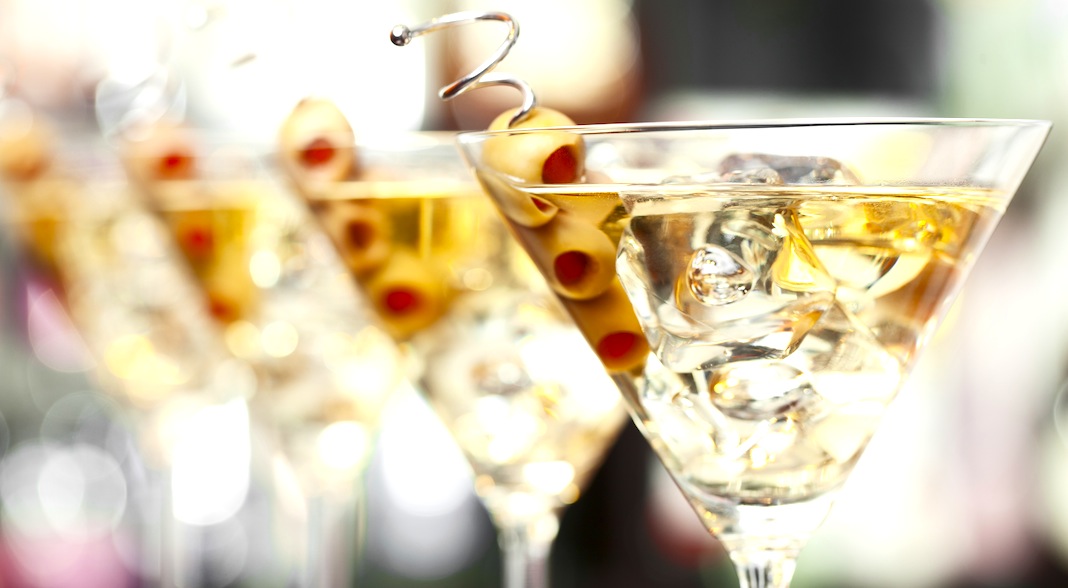Modern-twist cocktails will never be as good as the original. There’s perhaps no more distinguished example of this than the classic martini. Bartenders can make all the tweaks they want, adding interesting, creative and adventurous ingredients, but new twists to vintage dives are still new twists.
The extinction of the original martini has been proclaimed for years with the introduction of the ‘Appletini‘, the ‘Lycheetini‘, and a parade of other nouveau-‘tini’ variations. As lovely as these modern cocktails might sound, they bear no resemblance to the classic dry or dirty martini, with their only similarity being the iconically-shaped glass in which they are served. You can’t put a Fiat interior inside of a Bentley without raising a few eyebrows either.
Despite the martini’s classic place in cocktail history its pedigree is still hotly under debate. One popular theory cites its origins during the mid-1800s Gold Rush in Martinez, California, a small town whose current day inhabitants still insist that this is where the classic cocktail was invented. According to local lore it all started in a small Martintez bar, whose owner did not have the champagne his patron requested so instead he cobbled together an on-the-fly drink consisting of bitters, dry vermouth, maraschino liqueur, and gin. He added a slice of lemon for presentation, handed it over the bar and the rest is apparently martini history.
As the local story goes that patron loved the drink so much that on a subsequent trip to downtown San Francisco he ordered the “Martinez Special”, but the bartender had no clue what he was asking for. If there were a ‘Bottle Shock‘ movie moment for the martini this would be it. The patron instructed the bartender on how to make the drink and thereafter its reputation exploded. Another old school San Francisco story supports the martini’s Northern California roots in which patrons of the downtown Occidental Hotel who were awaiting their ferry to do business in Martinez across the Bay would request the ‘Martinez’ to bide their time. No matter its final origin, the martini is as American as whiskey. The first formal martini recipe was published in the Bartender’s Manual in the 1880s.
By the 1950s and 1960s, the martini had ascended into society’s most distinguished circles and it was soon the “done thing” amongst the world’s executive, power-broker circuit including the proverbial two martini business lunch—with perhaps another few at cocktail hour. Not surprisingly, now every bar and distillery wanted to lay claim to the original martini.
Barnaby Conrad III wrote a book on the origin of the martini and sticks to the claim that the cocktail was actually invented in San Frisco, California and not Martinez as originally thought. Another prevailing theory puts the martini’s origin at the Knickerbocker Hotel in New York and yet another assures us that it was created and named after Martini & Rossi Vermouth (first made in the mid-1800s), which is why it is thought that the cocktail was named “Martini”.
Origins aside most experts agree that the original martini consisted of gin and dry vermouth, and was served highly chilled in a v-shaped glass with the garnish being either a green olive or a twist of lemon. Why do some recipes call for vodka instead of gin though? And why do some others call for both in the mix?
Credit James Bond with that, who preferred his martini shaken and not stirred (see the recipe below for a delectable shaken classic martini). In his infamous words: “I’ve never tasted anything so cool and clean…They make me feel civilized.” Bond’s favorite, according to the Casino Royale novel by Ian Fleming, is known as the ‘Vesper” which is made with part gin, part vodka and a vermouth called Kina Lillet with a twist of zesty lemon peel. The drink was originally made with gin and this was the first mention of vodka being used in the mix. Bond however was soon drinking vodka martinis in the second novel, and Live and Let Die most likely added to vodka’s rise in popularity over gin during the 1970s. Bond’s love for the vodka martini has even inspired brands to design bottles especially for the films, Belvedere is currently selling a limited edition bottle for the newest Bond film Spectre.
These days, should the mix have vodka instead of gin, the drink is then known as a ‘Kangaroo” and when a cocktail onion is used in place of the traditional green olive, the drink is known as a “Gibson”. Another twist on the classic martini is whether it’s dirty or dry. A dirty one has a splash of olive brine and a dry one contains less vermouth - although that’s slightly confusing considering the ingredient is called ‘dry vermouth’.
Yet another variation to the classic martini is “with a twist” which means it includes a twist of zesty lemon peel, as per James Bond’s favorite, and “on the rocks” means that it is served in a glass poured over ice rather than being strained from the shaker, although some argue it is sacrilege to dilute the mix in this way!
Try the recipe below to make your own classic martini. Cheers!
Ingredients:
- 55ml (2 ounces) Gin or Vodka (or 3/4 gin and 1/4 vodka as per James Bond)
- 20ml (1/2 ounce) Dry Vermouth
- Ice (cubes or crush)
- Green Olives (stuffed with pimento)
1. Place the martini glasses in the freezer to chill
2. Pour the gin into a shaker with the ice cubes and shake until cold
3. Strain into the martini glass that has been chilling
4. Drop in the olives (number according to preference - usually 2 to 3)
5. Serve!
